Revolution of China Article 2022
VerifiedAdded on 2022/08/12
|11
|2213
|20
AI Summary
Research paper Topic Role of sun yat sen in 1911 revolution Minimum sources 4 Its research paper required in Chicago style Footnotes required Academic sources
Contribute Materials
Your contribution can guide someone’s learning journey. Share your
documents today.
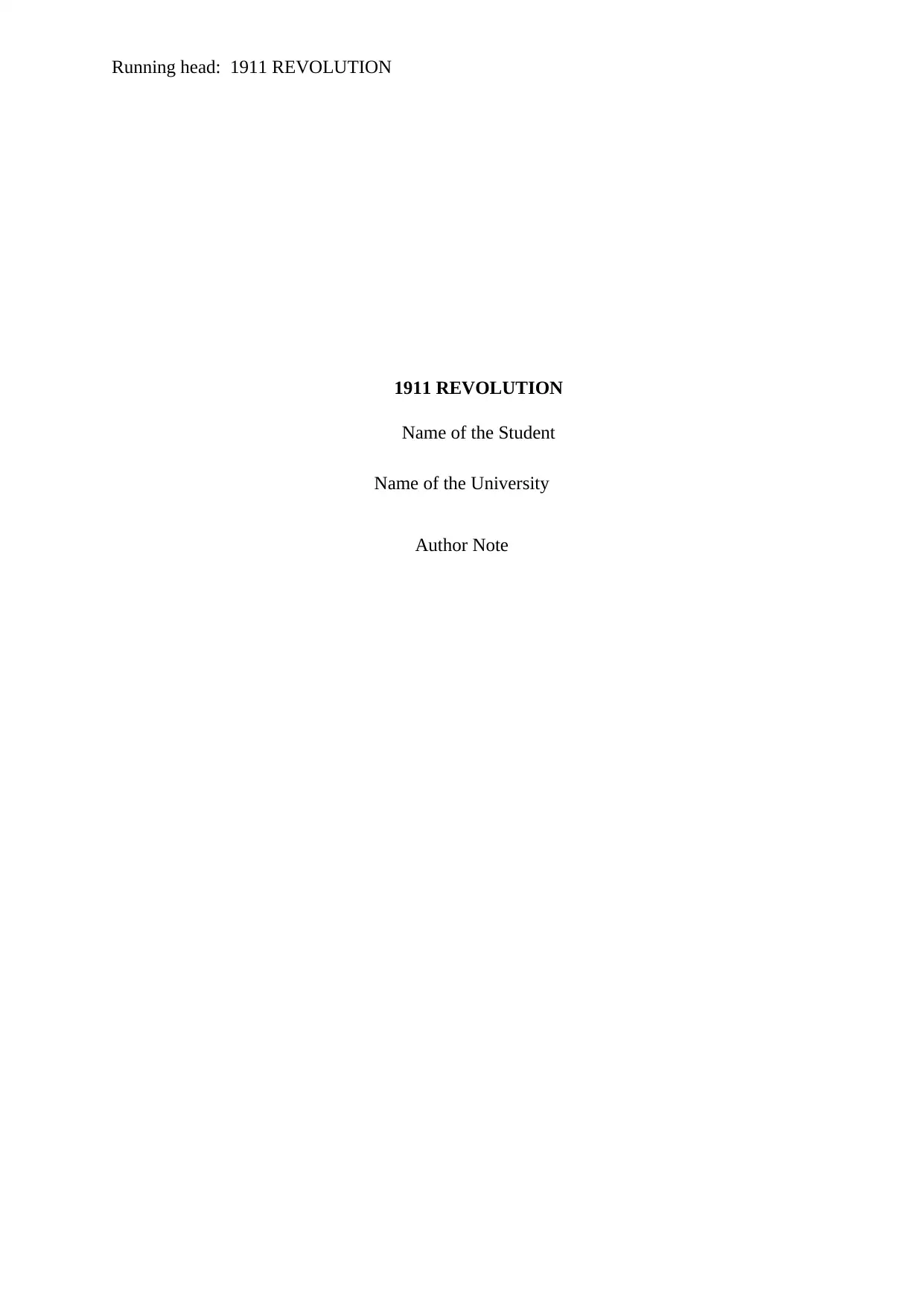
Running head: 1911 REVOLUTION
1911 REVOLUTION
Name of the Student
Name of the University
Author Note
1911 REVOLUTION
Name of the Student
Name of the University
Author Note
Secure Best Marks with AI Grader
Need help grading? Try our AI Grader for instant feedback on your assignments.
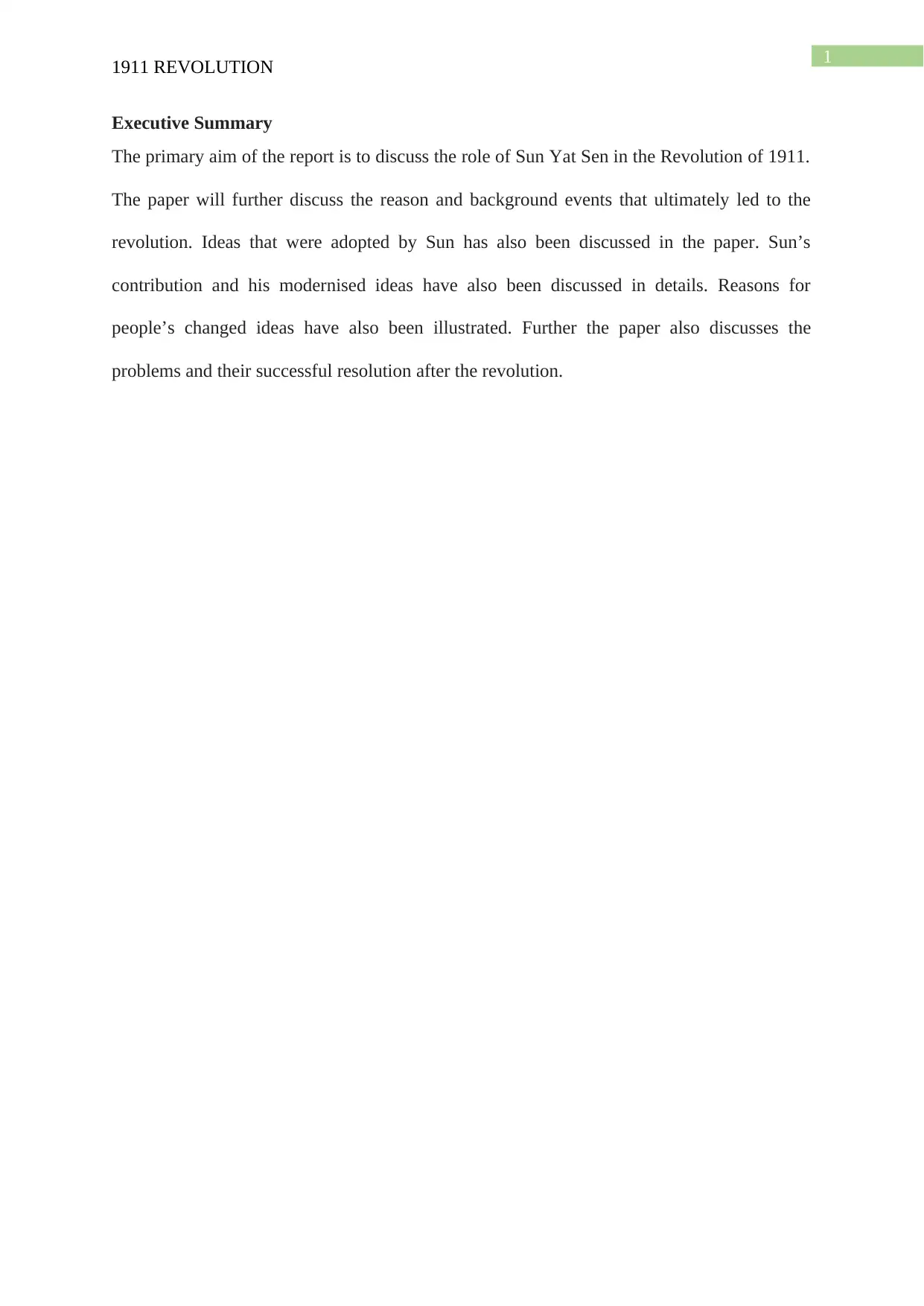
1
1911 REVOLUTION
Executive Summary
The primary aim of the report is to discuss the role of Sun Yat Sen in the Revolution of 1911.
The paper will further discuss the reason and background events that ultimately led to the
revolution. Ideas that were adopted by Sun has also been discussed in the paper. Sun’s
contribution and his modernised ideas have also been discussed in details. Reasons for
people’s changed ideas have also been illustrated. Further the paper also discusses the
problems and their successful resolution after the revolution.
1911 REVOLUTION
Executive Summary
The primary aim of the report is to discuss the role of Sun Yat Sen in the Revolution of 1911.
The paper will further discuss the reason and background events that ultimately led to the
revolution. Ideas that were adopted by Sun has also been discussed in the paper. Sun’s
contribution and his modernised ideas have also been discussed in details. Reasons for
people’s changed ideas have also been illustrated. Further the paper also discusses the
problems and their successful resolution after the revolution.
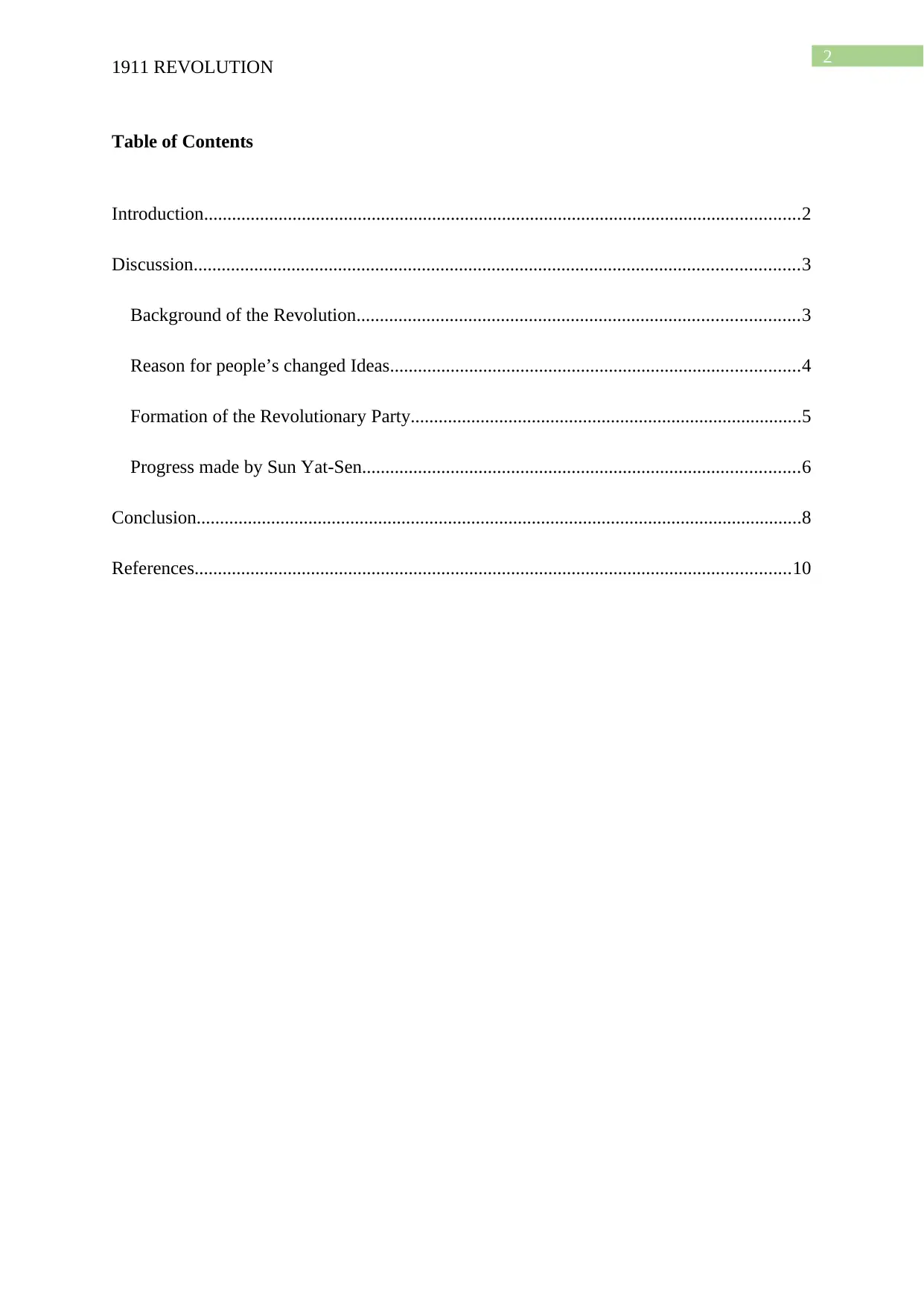
2
1911 REVOLUTION
Table of Contents
Introduction................................................................................................................................2
Discussion..................................................................................................................................3
Background of the Revolution...............................................................................................3
Reason for people’s changed Ideas........................................................................................4
Formation of the Revolutionary Party....................................................................................5
Progress made by Sun Yat-Sen..............................................................................................6
Conclusion..................................................................................................................................8
References................................................................................................................................10
1911 REVOLUTION
Table of Contents
Introduction................................................................................................................................2
Discussion..................................................................................................................................3
Background of the Revolution...............................................................................................3
Reason for people’s changed Ideas........................................................................................4
Formation of the Revolutionary Party....................................................................................5
Progress made by Sun Yat-Sen..............................................................................................6
Conclusion..................................................................................................................................8
References................................................................................................................................10
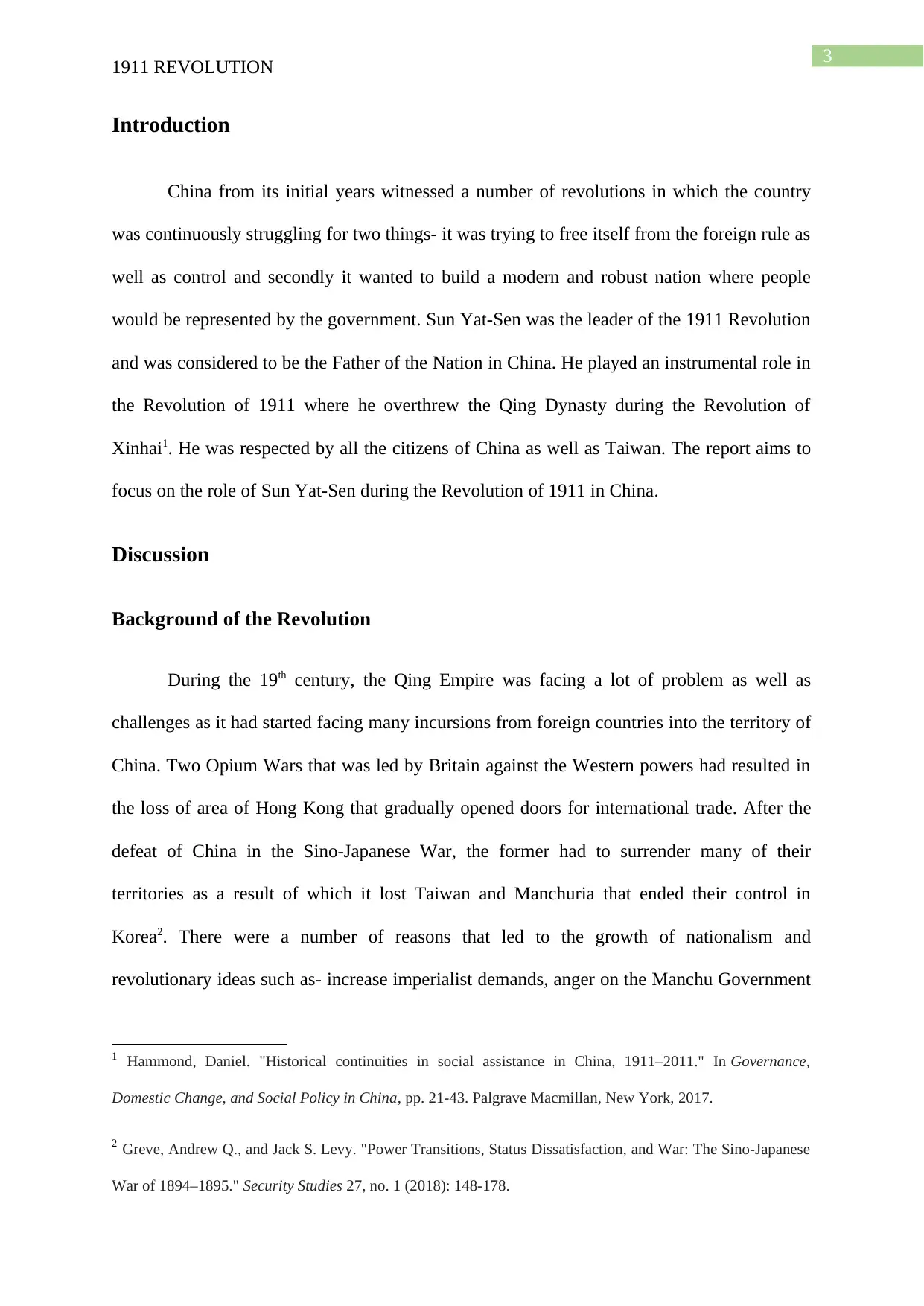
3
1911 REVOLUTION
Introduction
China from its initial years witnessed a number of revolutions in which the country
was continuously struggling for two things- it was trying to free itself from the foreign rule as
well as control and secondly it wanted to build a modern and robust nation where people
would be represented by the government. Sun Yat-Sen was the leader of the 1911 Revolution
and was considered to be the Father of the Nation in China. He played an instrumental role in
the Revolution of 1911 where he overthrew the Qing Dynasty during the Revolution of
Xinhai1. He was respected by all the citizens of China as well as Taiwan. The report aims to
focus on the role of Sun Yat-Sen during the Revolution of 1911 in China.
Discussion
Background of the Revolution
During the 19th century, the Qing Empire was facing a lot of problem as well as
challenges as it had started facing many incursions from foreign countries into the territory of
China. Two Opium Wars that was led by Britain against the Western powers had resulted in
the loss of area of Hong Kong that gradually opened doors for international trade. After the
defeat of China in the Sino-Japanese War, the former had to surrender many of their
territories as a result of which it lost Taiwan and Manchuria that ended their control in
Korea2. There were a number of reasons that led to the growth of nationalism and
revolutionary ideas such as- increase imperialist demands, anger on the Manchu Government
1 Hammond, Daniel. "Historical continuities in social assistance in China, 1911–2011." In Governance,
Domestic Change, and Social Policy in China, pp. 21-43. Palgrave Macmillan, New York, 2017.
2 Greve, Andrew Q., and Jack S. Levy. "Power Transitions, Status Dissatisfaction, and War: The Sino-Japanese
War of 1894–1895." Security Studies 27, no. 1 (2018): 148-178.
1911 REVOLUTION
Introduction
China from its initial years witnessed a number of revolutions in which the country
was continuously struggling for two things- it was trying to free itself from the foreign rule as
well as control and secondly it wanted to build a modern and robust nation where people
would be represented by the government. Sun Yat-Sen was the leader of the 1911 Revolution
and was considered to be the Father of the Nation in China. He played an instrumental role in
the Revolution of 1911 where he overthrew the Qing Dynasty during the Revolution of
Xinhai1. He was respected by all the citizens of China as well as Taiwan. The report aims to
focus on the role of Sun Yat-Sen during the Revolution of 1911 in China.
Discussion
Background of the Revolution
During the 19th century, the Qing Empire was facing a lot of problem as well as
challenges as it had started facing many incursions from foreign countries into the territory of
China. Two Opium Wars that was led by Britain against the Western powers had resulted in
the loss of area of Hong Kong that gradually opened doors for international trade. After the
defeat of China in the Sino-Japanese War, the former had to surrender many of their
territories as a result of which it lost Taiwan and Manchuria that ended their control in
Korea2. There were a number of reasons that led to the growth of nationalism and
revolutionary ideas such as- increase imperialist demands, anger on the Manchu Government
1 Hammond, Daniel. "Historical continuities in social assistance in China, 1911–2011." In Governance,
Domestic Change, and Social Policy in China, pp. 21-43. Palgrave Macmillan, New York, 2017.
2 Greve, Andrew Q., and Jack S. Levy. "Power Transitions, Status Dissatisfaction, and War: The Sino-Japanese
War of 1894–1895." Security Studies 27, no. 1 (2018): 148-178.
Secure Best Marks with AI Grader
Need help grading? Try our AI Grader for instant feedback on your assignments.
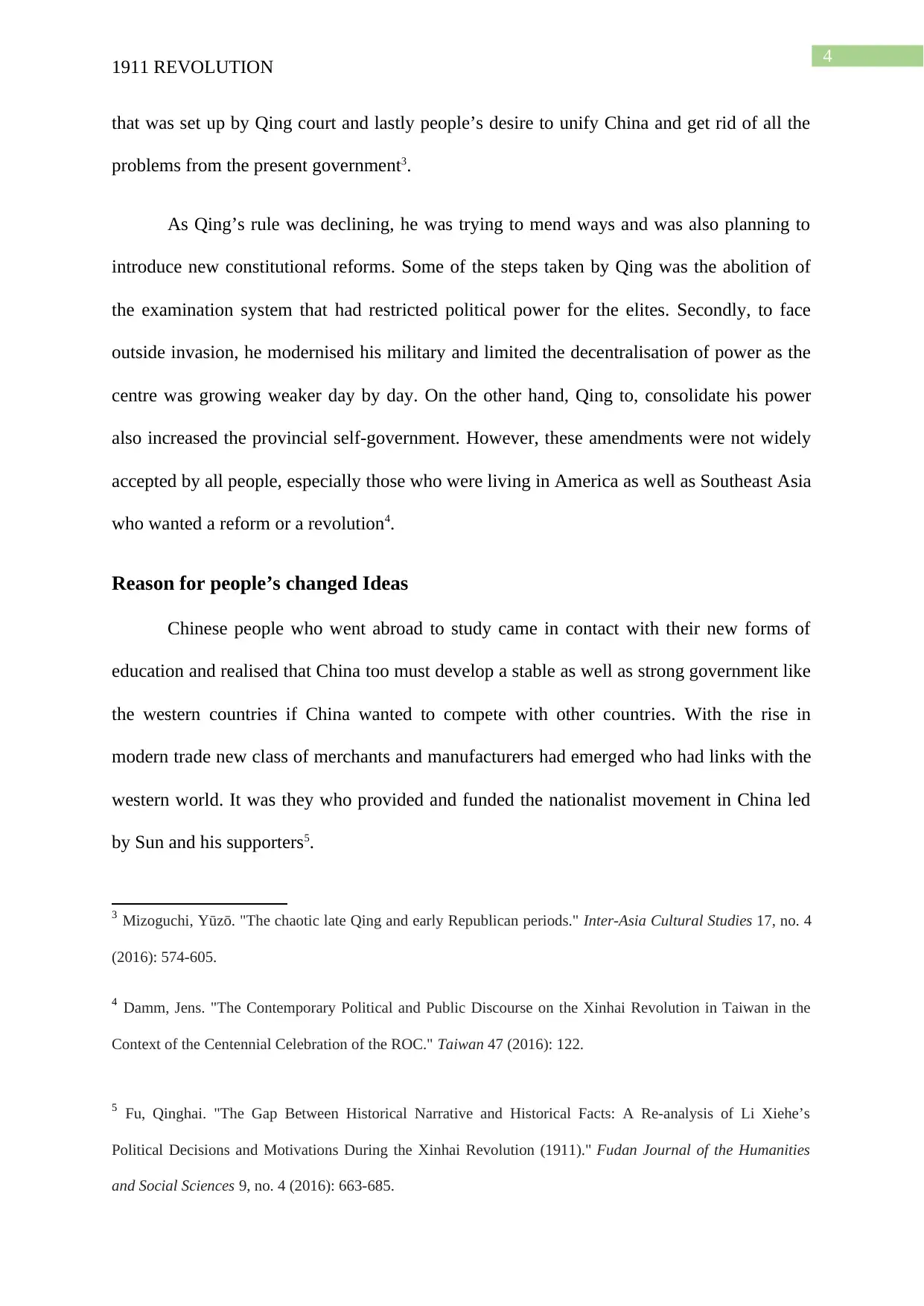
4
1911 REVOLUTION
that was set up by Qing court and lastly people’s desire to unify China and get rid of all the
problems from the present government3.
As Qing’s rule was declining, he was trying to mend ways and was also planning to
introduce new constitutional reforms. Some of the steps taken by Qing was the abolition of
the examination system that had restricted political power for the elites. Secondly, to face
outside invasion, he modernised his military and limited the decentralisation of power as the
centre was growing weaker day by day. On the other hand, Qing to, consolidate his power
also increased the provincial self-government. However, these amendments were not widely
accepted by all people, especially those who were living in America as well as Southeast Asia
who wanted a reform or a revolution4.
Reason for people’s changed Ideas
Chinese people who went abroad to study came in contact with their new forms of
education and realised that China too must develop a stable as well as strong government like
the western countries if China wanted to compete with other countries. With the rise in
modern trade new class of merchants and manufacturers had emerged who had links with the
western world. It was they who provided and funded the nationalist movement in China led
by Sun and his supporters5.
3 Mizoguchi, Yūzō. "The chaotic late Qing and early Republican periods." Inter-Asia Cultural Studies 17, no. 4
(2016): 574-605.
4 Damm, Jens. "The Contemporary Political and Public Discourse on the Xinhai Revolution in Taiwan in the
Context of the Centennial Celebration of the ROC." Taiwan 47 (2016): 122.
5 Fu, Qinghai. "The Gap Between Historical Narrative and Historical Facts: A Re-analysis of Li Xiehe’s
Political Decisions and Motivations During the Xinhai Revolution (1911)." Fudan Journal of the Humanities
and Social Sciences 9, no. 4 (2016): 663-685.
1911 REVOLUTION
that was set up by Qing court and lastly people’s desire to unify China and get rid of all the
problems from the present government3.
As Qing’s rule was declining, he was trying to mend ways and was also planning to
introduce new constitutional reforms. Some of the steps taken by Qing was the abolition of
the examination system that had restricted political power for the elites. Secondly, to face
outside invasion, he modernised his military and limited the decentralisation of power as the
centre was growing weaker day by day. On the other hand, Qing to, consolidate his power
also increased the provincial self-government. However, these amendments were not widely
accepted by all people, especially those who were living in America as well as Southeast Asia
who wanted a reform or a revolution4.
Reason for people’s changed Ideas
Chinese people who went abroad to study came in contact with their new forms of
education and realised that China too must develop a stable as well as strong government like
the western countries if China wanted to compete with other countries. With the rise in
modern trade new class of merchants and manufacturers had emerged who had links with the
western world. It was they who provided and funded the nationalist movement in China led
by Sun and his supporters5.
3 Mizoguchi, Yūzō. "The chaotic late Qing and early Republican periods." Inter-Asia Cultural Studies 17, no. 4
(2016): 574-605.
4 Damm, Jens. "The Contemporary Political and Public Discourse on the Xinhai Revolution in Taiwan in the
Context of the Centennial Celebration of the ROC." Taiwan 47 (2016): 122.
5 Fu, Qinghai. "The Gap Between Historical Narrative and Historical Facts: A Re-analysis of Li Xiehe’s
Political Decisions and Motivations During the Xinhai Revolution (1911)." Fudan Journal of the Humanities
and Social Sciences 9, no. 4 (2016): 663-685.
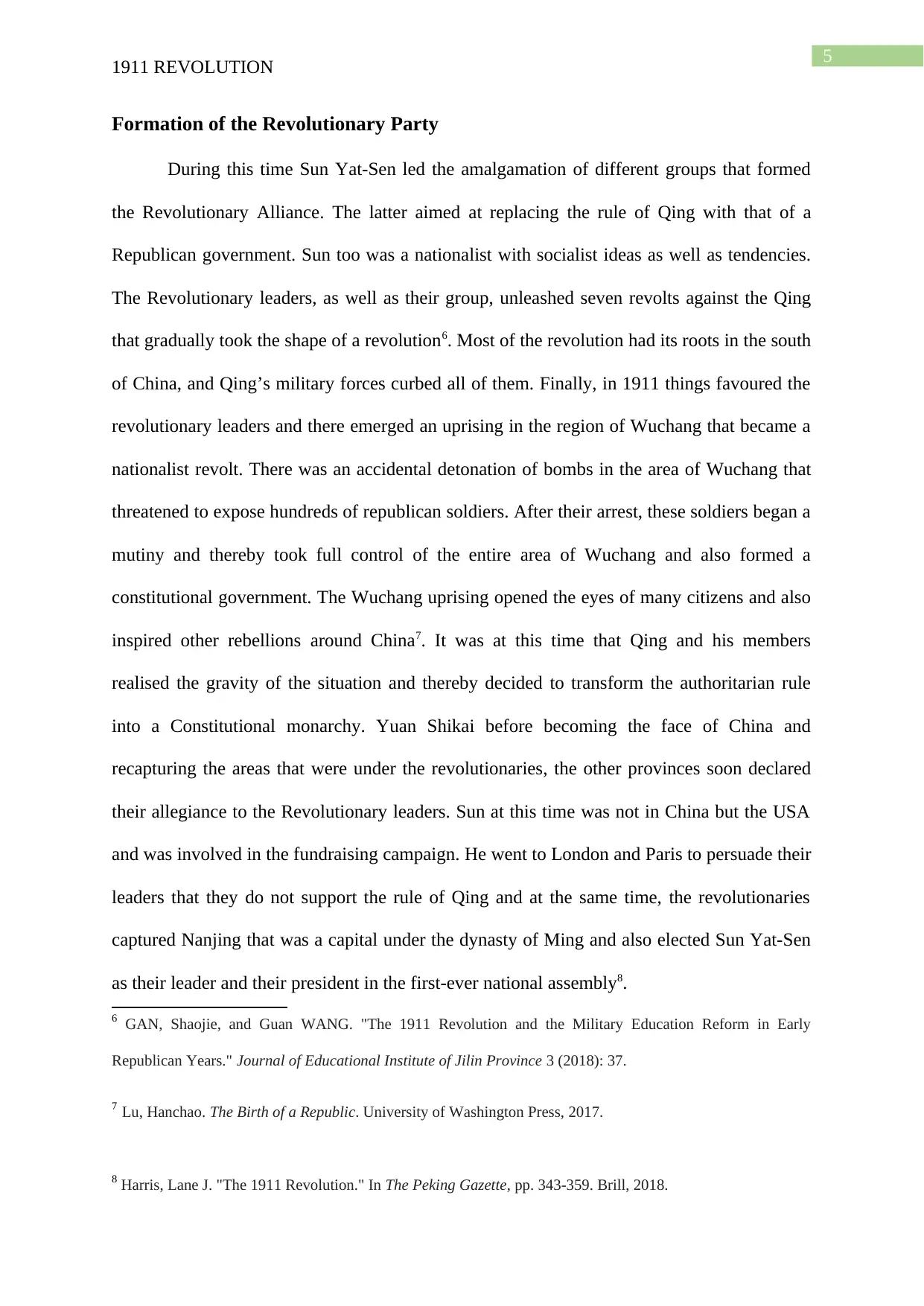
5
1911 REVOLUTION
Formation of the Revolutionary Party
During this time Sun Yat-Sen led the amalgamation of different groups that formed
the Revolutionary Alliance. The latter aimed at replacing the rule of Qing with that of a
Republican government. Sun too was a nationalist with socialist ideas as well as tendencies.
The Revolutionary leaders, as well as their group, unleashed seven revolts against the Qing
that gradually took the shape of a revolution6. Most of the revolution had its roots in the south
of China, and Qing’s military forces curbed all of them. Finally, in 1911 things favoured the
revolutionary leaders and there emerged an uprising in the region of Wuchang that became a
nationalist revolt. There was an accidental detonation of bombs in the area of Wuchang that
threatened to expose hundreds of republican soldiers. After their arrest, these soldiers began a
mutiny and thereby took full control of the entire area of Wuchang and also formed a
constitutional government. The Wuchang uprising opened the eyes of many citizens and also
inspired other rebellions around China7. It was at this time that Qing and his members
realised the gravity of the situation and thereby decided to transform the authoritarian rule
into a Constitutional monarchy. Yuan Shikai before becoming the face of China and
recapturing the areas that were under the revolutionaries, the other provinces soon declared
their allegiance to the Revolutionary leaders. Sun at this time was not in China but the USA
and was involved in the fundraising campaign. He went to London and Paris to persuade their
leaders that they do not support the rule of Qing and at the same time, the revolutionaries
captured Nanjing that was a capital under the dynasty of Ming and also elected Sun Yat-Sen
as their leader and their president in the first-ever national assembly8.
6 GAN, Shaojie, and Guan WANG. "The 1911 Revolution and the Military Education Reform in Early
Republican Years." Journal of Educational Institute of Jilin Province 3 (2018): 37.
7 Lu, Hanchao. The Birth of a Republic. University of Washington Press, 2017.
8 Harris, Lane J. "The 1911 Revolution." In The Peking Gazette, pp. 343-359. Brill, 2018.
1911 REVOLUTION
Formation of the Revolutionary Party
During this time Sun Yat-Sen led the amalgamation of different groups that formed
the Revolutionary Alliance. The latter aimed at replacing the rule of Qing with that of a
Republican government. Sun too was a nationalist with socialist ideas as well as tendencies.
The Revolutionary leaders, as well as their group, unleashed seven revolts against the Qing
that gradually took the shape of a revolution6. Most of the revolution had its roots in the south
of China, and Qing’s military forces curbed all of them. Finally, in 1911 things favoured the
revolutionary leaders and there emerged an uprising in the region of Wuchang that became a
nationalist revolt. There was an accidental detonation of bombs in the area of Wuchang that
threatened to expose hundreds of republican soldiers. After their arrest, these soldiers began a
mutiny and thereby took full control of the entire area of Wuchang and also formed a
constitutional government. The Wuchang uprising opened the eyes of many citizens and also
inspired other rebellions around China7. It was at this time that Qing and his members
realised the gravity of the situation and thereby decided to transform the authoritarian rule
into a Constitutional monarchy. Yuan Shikai before becoming the face of China and
recapturing the areas that were under the revolutionaries, the other provinces soon declared
their allegiance to the Revolutionary leaders. Sun at this time was not in China but the USA
and was involved in the fundraising campaign. He went to London and Paris to persuade their
leaders that they do not support the rule of Qing and at the same time, the revolutionaries
captured Nanjing that was a capital under the dynasty of Ming and also elected Sun Yat-Sen
as their leader and their president in the first-ever national assembly8.
6 GAN, Shaojie, and Guan WANG. "The 1911 Revolution and the Military Education Reform in Early
Republican Years." Journal of Educational Institute of Jilin Province 3 (2018): 37.
7 Lu, Hanchao. The Birth of a Republic. University of Washington Press, 2017.
8 Harris, Lane J. "The 1911 Revolution." In The Peking Gazette, pp. 343-359. Brill, 2018.
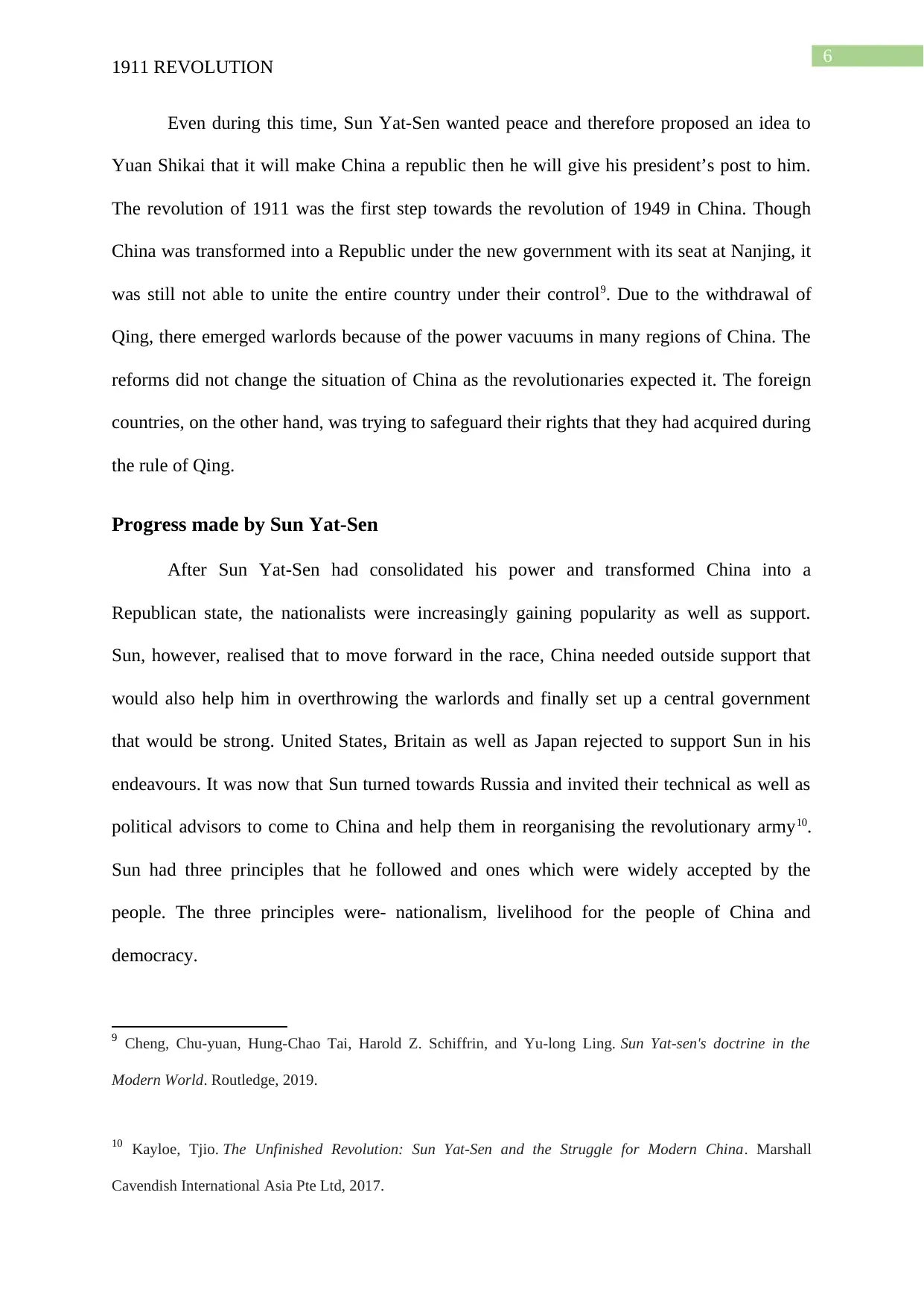
6
1911 REVOLUTION
Even during this time, Sun Yat-Sen wanted peace and therefore proposed an idea to
Yuan Shikai that it will make China a republic then he will give his president’s post to him.
The revolution of 1911 was the first step towards the revolution of 1949 in China. Though
China was transformed into a Republic under the new government with its seat at Nanjing, it
was still not able to unite the entire country under their control9. Due to the withdrawal of
Qing, there emerged warlords because of the power vacuums in many regions of China. The
reforms did not change the situation of China as the revolutionaries expected it. The foreign
countries, on the other hand, was trying to safeguard their rights that they had acquired during
the rule of Qing.
Progress made by Sun Yat-Sen
After Sun Yat-Sen had consolidated his power and transformed China into a
Republican state, the nationalists were increasingly gaining popularity as well as support.
Sun, however, realised that to move forward in the race, China needed outside support that
would also help him in overthrowing the warlords and finally set up a central government
that would be strong. United States, Britain as well as Japan rejected to support Sun in his
endeavours. It was now that Sun turned towards Russia and invited their technical as well as
political advisors to come to China and help them in reorganising the revolutionary army10.
Sun had three principles that he followed and ones which were widely accepted by the
people. The three principles were- nationalism, livelihood for the people of China and
democracy.
9 Cheng, Chu-yuan, Hung-Chao Tai, Harold Z. Schiffrin, and Yu-long Ling. Sun Yat-sen's doctrine in the
Modern World. Routledge, 2019.
10 Kayloe, Tjio. The Unfinished Revolution: Sun Yat-Sen and the Struggle for Modern China. Marshall
Cavendish International Asia Pte Ltd, 2017.
1911 REVOLUTION
Even during this time, Sun Yat-Sen wanted peace and therefore proposed an idea to
Yuan Shikai that it will make China a republic then he will give his president’s post to him.
The revolution of 1911 was the first step towards the revolution of 1949 in China. Though
China was transformed into a Republic under the new government with its seat at Nanjing, it
was still not able to unite the entire country under their control9. Due to the withdrawal of
Qing, there emerged warlords because of the power vacuums in many regions of China. The
reforms did not change the situation of China as the revolutionaries expected it. The foreign
countries, on the other hand, was trying to safeguard their rights that they had acquired during
the rule of Qing.
Progress made by Sun Yat-Sen
After Sun Yat-Sen had consolidated his power and transformed China into a
Republican state, the nationalists were increasingly gaining popularity as well as support.
Sun, however, realised that to move forward in the race, China needed outside support that
would also help him in overthrowing the warlords and finally set up a central government
that would be strong. United States, Britain as well as Japan rejected to support Sun in his
endeavours. It was now that Sun turned towards Russia and invited their technical as well as
political advisors to come to China and help them in reorganising the revolutionary army10.
Sun had three principles that he followed and ones which were widely accepted by the
people. The three principles were- nationalism, livelihood for the people of China and
democracy.
9 Cheng, Chu-yuan, Hung-Chao Tai, Harold Z. Schiffrin, and Yu-long Ling. Sun Yat-sen's doctrine in the
Modern World. Routledge, 2019.
10 Kayloe, Tjio. The Unfinished Revolution: Sun Yat-Sen and the Struggle for Modern China. Marshall
Cavendish International Asia Pte Ltd, 2017.
Paraphrase This Document
Need a fresh take? Get an instant paraphrase of this document with our AI Paraphraser
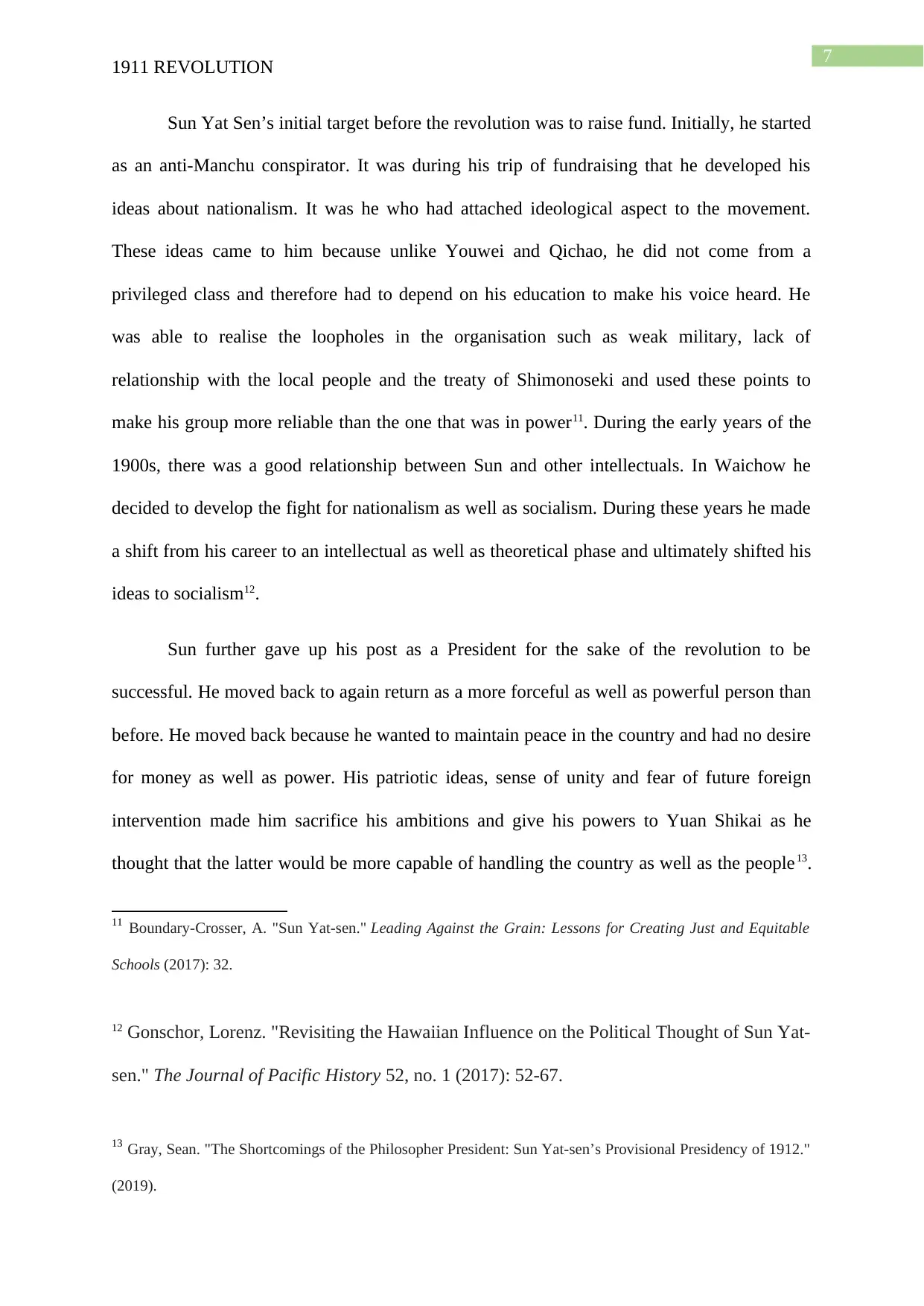
7
1911 REVOLUTION
Sun Yat Sen’s initial target before the revolution was to raise fund. Initially, he started
as an anti-Manchu conspirator. It was during his trip of fundraising that he developed his
ideas about nationalism. It was he who had attached ideological aspect to the movement.
These ideas came to him because unlike Youwei and Qichao, he did not come from a
privileged class and therefore had to depend on his education to make his voice heard. He
was able to realise the loopholes in the organisation such as weak military, lack of
relationship with the local people and the treaty of Shimonoseki and used these points to
make his group more reliable than the one that was in power11. During the early years of the
1900s, there was a good relationship between Sun and other intellectuals. In Waichow he
decided to develop the fight for nationalism as well as socialism. During these years he made
a shift from his career to an intellectual as well as theoretical phase and ultimately shifted his
ideas to socialism12.
Sun further gave up his post as a President for the sake of the revolution to be
successful. He moved back to again return as a more forceful as well as powerful person than
before. He moved back because he wanted to maintain peace in the country and had no desire
for money as well as power. His patriotic ideas, sense of unity and fear of future foreign
intervention made him sacrifice his ambitions and give his powers to Yuan Shikai as he
thought that the latter would be more capable of handling the country as well as the people13.
11 Boundary-Crosser, A. "Sun Yat-sen." Leading Against the Grain: Lessons for Creating Just and Equitable
Schools (2017): 32.
12 Gonschor, Lorenz. "Revisiting the Hawaiian Influence on the Political Thought of Sun Yat-
sen." The Journal of Pacific History 52, no. 1 (2017): 52-67.
13 Gray, Sean. "The Shortcomings of the Philosopher President: Sun Yat-sen’s Provisional Presidency of 1912."
(2019).
1911 REVOLUTION
Sun Yat Sen’s initial target before the revolution was to raise fund. Initially, he started
as an anti-Manchu conspirator. It was during his trip of fundraising that he developed his
ideas about nationalism. It was he who had attached ideological aspect to the movement.
These ideas came to him because unlike Youwei and Qichao, he did not come from a
privileged class and therefore had to depend on his education to make his voice heard. He
was able to realise the loopholes in the organisation such as weak military, lack of
relationship with the local people and the treaty of Shimonoseki and used these points to
make his group more reliable than the one that was in power11. During the early years of the
1900s, there was a good relationship between Sun and other intellectuals. In Waichow he
decided to develop the fight for nationalism as well as socialism. During these years he made
a shift from his career to an intellectual as well as theoretical phase and ultimately shifted his
ideas to socialism12.
Sun further gave up his post as a President for the sake of the revolution to be
successful. He moved back to again return as a more forceful as well as powerful person than
before. He moved back because he wanted to maintain peace in the country and had no desire
for money as well as power. His patriotic ideas, sense of unity and fear of future foreign
intervention made him sacrifice his ambitions and give his powers to Yuan Shikai as he
thought that the latter would be more capable of handling the country as well as the people13.
11 Boundary-Crosser, A. "Sun Yat-sen." Leading Against the Grain: Lessons for Creating Just and Equitable
Schools (2017): 32.
12 Gonschor, Lorenz. "Revisiting the Hawaiian Influence on the Political Thought of Sun Yat-
sen." The Journal of Pacific History 52, no. 1 (2017): 52-67.
13 Gray, Sean. "The Shortcomings of the Philosopher President: Sun Yat-sen’s Provisional Presidency of 1912."
(2019).
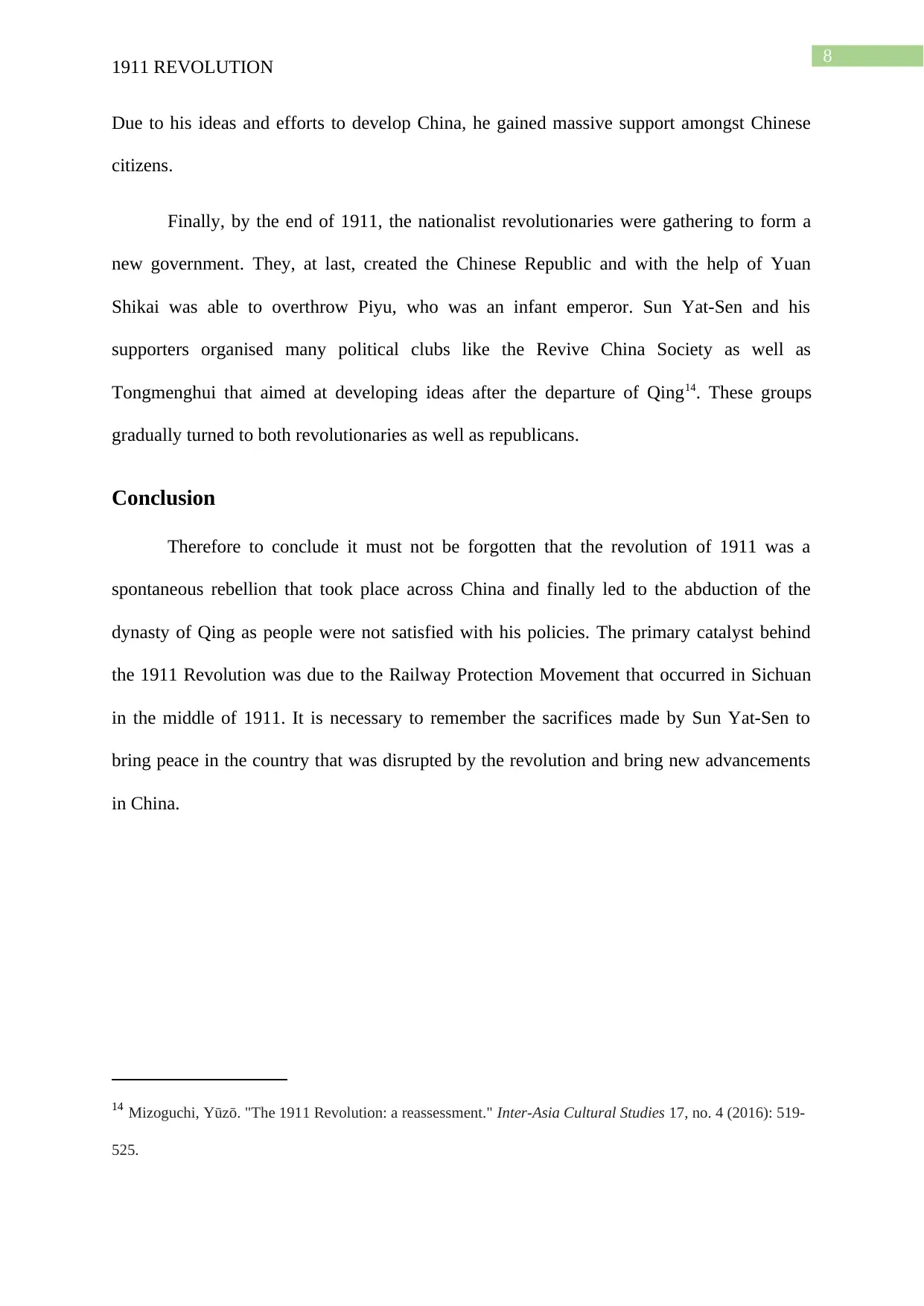
8
1911 REVOLUTION
Due to his ideas and efforts to develop China, he gained massive support amongst Chinese
citizens.
Finally, by the end of 1911, the nationalist revolutionaries were gathering to form a
new government. They, at last, created the Chinese Republic and with the help of Yuan
Shikai was able to overthrow Piyu, who was an infant emperor. Sun Yat-Sen and his
supporters organised many political clubs like the Revive China Society as well as
Tongmenghui that aimed at developing ideas after the departure of Qing14. These groups
gradually turned to both revolutionaries as well as republicans.
Conclusion
Therefore to conclude it must not be forgotten that the revolution of 1911 was a
spontaneous rebellion that took place across China and finally led to the abduction of the
dynasty of Qing as people were not satisfied with his policies. The primary catalyst behind
the 1911 Revolution was due to the Railway Protection Movement that occurred in Sichuan
in the middle of 1911. It is necessary to remember the sacrifices made by Sun Yat-Sen to
bring peace in the country that was disrupted by the revolution and bring new advancements
in China.
14 Mizoguchi, Yūzō. "The 1911 Revolution: a reassessment." Inter-Asia Cultural Studies 17, no. 4 (2016): 519-
525.
1911 REVOLUTION
Due to his ideas and efforts to develop China, he gained massive support amongst Chinese
citizens.
Finally, by the end of 1911, the nationalist revolutionaries were gathering to form a
new government. They, at last, created the Chinese Republic and with the help of Yuan
Shikai was able to overthrow Piyu, who was an infant emperor. Sun Yat-Sen and his
supporters organised many political clubs like the Revive China Society as well as
Tongmenghui that aimed at developing ideas after the departure of Qing14. These groups
gradually turned to both revolutionaries as well as republicans.
Conclusion
Therefore to conclude it must not be forgotten that the revolution of 1911 was a
spontaneous rebellion that took place across China and finally led to the abduction of the
dynasty of Qing as people were not satisfied with his policies. The primary catalyst behind
the 1911 Revolution was due to the Railway Protection Movement that occurred in Sichuan
in the middle of 1911. It is necessary to remember the sacrifices made by Sun Yat-Sen to
bring peace in the country that was disrupted by the revolution and bring new advancements
in China.
14 Mizoguchi, Yūzō. "The 1911 Revolution: a reassessment." Inter-Asia Cultural Studies 17, no. 4 (2016): 519-
525.
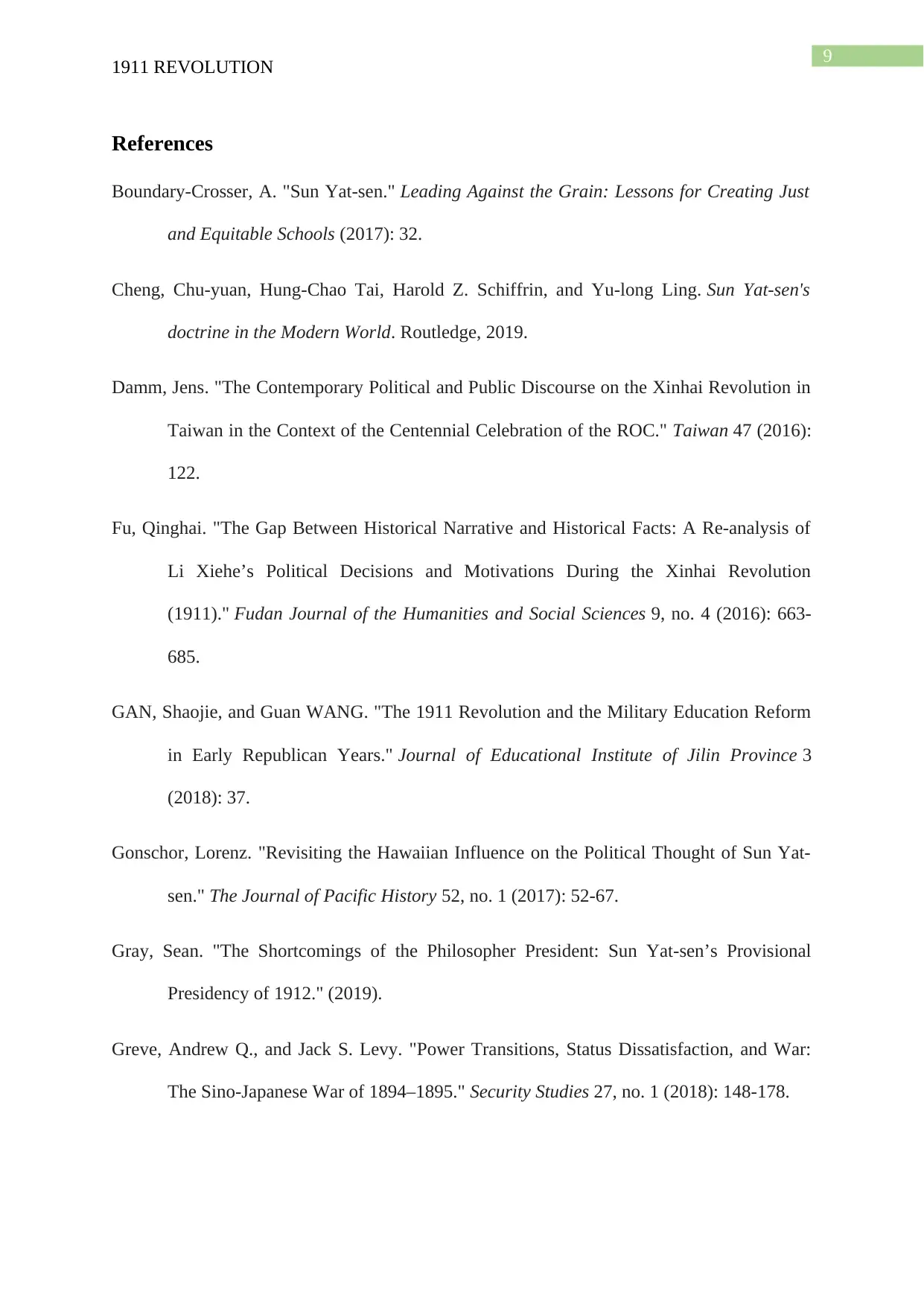
9
1911 REVOLUTION
References
Boundary-Crosser, A. "Sun Yat-sen." Leading Against the Grain: Lessons for Creating Just
and Equitable Schools (2017): 32.
Cheng, Chu-yuan, Hung-Chao Tai, Harold Z. Schiffrin, and Yu-long Ling. Sun Yat-sen's
doctrine in the Modern World. Routledge, 2019.
Damm, Jens. "The Contemporary Political and Public Discourse on the Xinhai Revolution in
Taiwan in the Context of the Centennial Celebration of the ROC." Taiwan 47 (2016):
122.
Fu, Qinghai. "The Gap Between Historical Narrative and Historical Facts: A Re-analysis of
Li Xiehe’s Political Decisions and Motivations During the Xinhai Revolution
(1911)." Fudan Journal of the Humanities and Social Sciences 9, no. 4 (2016): 663-
685.
GAN, Shaojie, and Guan WANG. "The 1911 Revolution and the Military Education Reform
in Early Republican Years." Journal of Educational Institute of Jilin Province 3
(2018): 37.
Gonschor, Lorenz. "Revisiting the Hawaiian Influence on the Political Thought of Sun Yat-
sen." The Journal of Pacific History 52, no. 1 (2017): 52-67.
Gray, Sean. "The Shortcomings of the Philosopher President: Sun Yat-sen’s Provisional
Presidency of 1912." (2019).
Greve, Andrew Q., and Jack S. Levy. "Power Transitions, Status Dissatisfaction, and War:
The Sino-Japanese War of 1894–1895." Security Studies 27, no. 1 (2018): 148-178.
1911 REVOLUTION
References
Boundary-Crosser, A. "Sun Yat-sen." Leading Against the Grain: Lessons for Creating Just
and Equitable Schools (2017): 32.
Cheng, Chu-yuan, Hung-Chao Tai, Harold Z. Schiffrin, and Yu-long Ling. Sun Yat-sen's
doctrine in the Modern World. Routledge, 2019.
Damm, Jens. "The Contemporary Political and Public Discourse on the Xinhai Revolution in
Taiwan in the Context of the Centennial Celebration of the ROC." Taiwan 47 (2016):
122.
Fu, Qinghai. "The Gap Between Historical Narrative and Historical Facts: A Re-analysis of
Li Xiehe’s Political Decisions and Motivations During the Xinhai Revolution
(1911)." Fudan Journal of the Humanities and Social Sciences 9, no. 4 (2016): 663-
685.
GAN, Shaojie, and Guan WANG. "The 1911 Revolution and the Military Education Reform
in Early Republican Years." Journal of Educational Institute of Jilin Province 3
(2018): 37.
Gonschor, Lorenz. "Revisiting the Hawaiian Influence on the Political Thought of Sun Yat-
sen." The Journal of Pacific History 52, no. 1 (2017): 52-67.
Gray, Sean. "The Shortcomings of the Philosopher President: Sun Yat-sen’s Provisional
Presidency of 1912." (2019).
Greve, Andrew Q., and Jack S. Levy. "Power Transitions, Status Dissatisfaction, and War:
The Sino-Japanese War of 1894–1895." Security Studies 27, no. 1 (2018): 148-178.
Secure Best Marks with AI Grader
Need help grading? Try our AI Grader for instant feedback on your assignments.
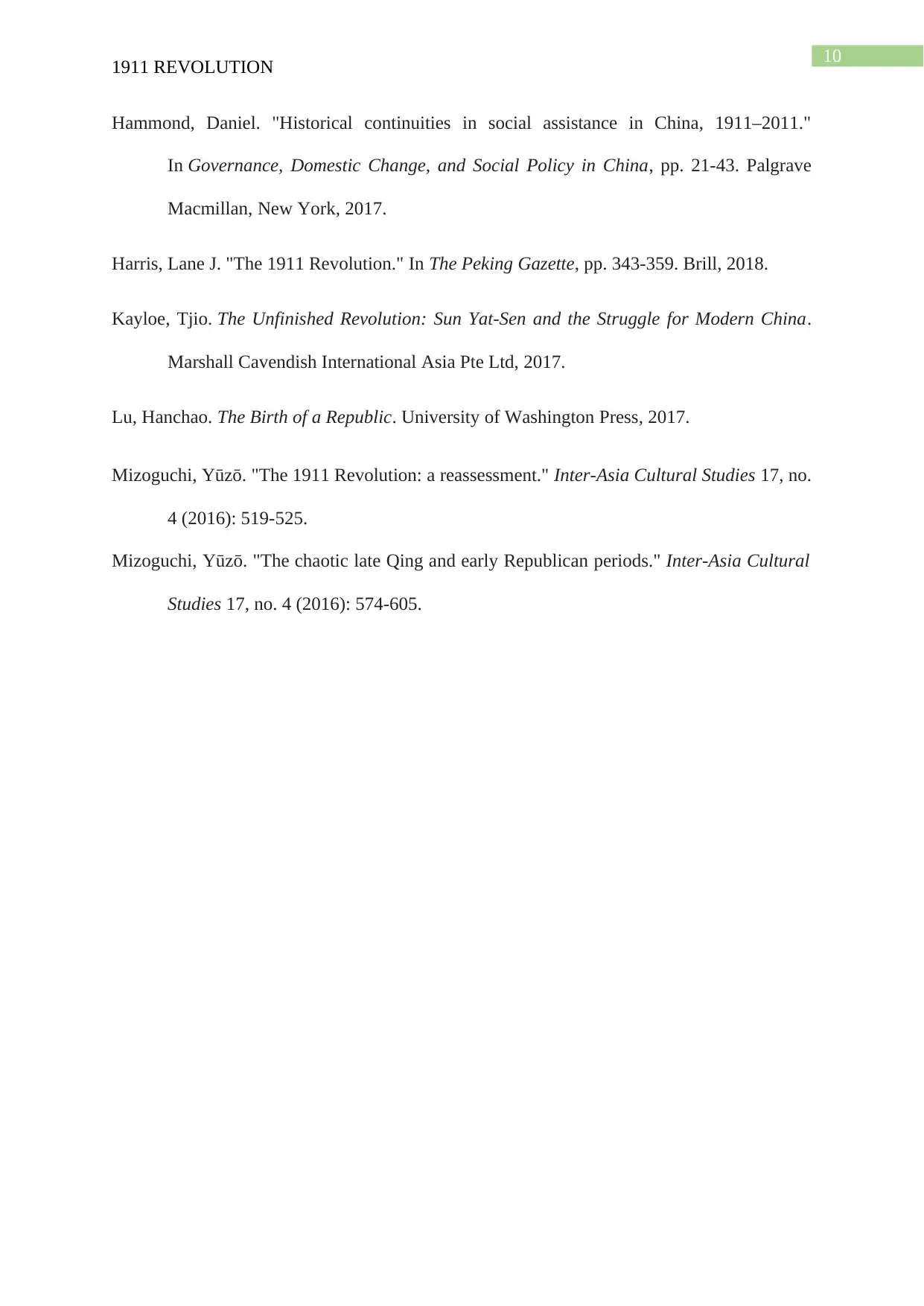
10
1911 REVOLUTION
Hammond, Daniel. "Historical continuities in social assistance in China, 1911–2011."
In Governance, Domestic Change, and Social Policy in China, pp. 21-43. Palgrave
Macmillan, New York, 2017.
Harris, Lane J. "The 1911 Revolution." In The Peking Gazette, pp. 343-359. Brill, 2018.
Kayloe, Tjio. The Unfinished Revolution: Sun Yat-Sen and the Struggle for Modern China.
Marshall Cavendish International Asia Pte Ltd, 2017.
Lu, Hanchao. The Birth of a Republic. University of Washington Press, 2017.
Mizoguchi, Yūzō. "The 1911 Revolution: a reassessment." Inter-Asia Cultural Studies 17, no.
4 (2016): 519-525.
Mizoguchi, Yūzō. "The chaotic late Qing and early Republican periods." Inter-Asia Cultural
Studies 17, no. 4 (2016): 574-605.
1911 REVOLUTION
Hammond, Daniel. "Historical continuities in social assistance in China, 1911–2011."
In Governance, Domestic Change, and Social Policy in China, pp. 21-43. Palgrave
Macmillan, New York, 2017.
Harris, Lane J. "The 1911 Revolution." In The Peking Gazette, pp. 343-359. Brill, 2018.
Kayloe, Tjio. The Unfinished Revolution: Sun Yat-Sen and the Struggle for Modern China.
Marshall Cavendish International Asia Pte Ltd, 2017.
Lu, Hanchao. The Birth of a Republic. University of Washington Press, 2017.
Mizoguchi, Yūzō. "The 1911 Revolution: a reassessment." Inter-Asia Cultural Studies 17, no.
4 (2016): 519-525.
Mizoguchi, Yūzō. "The chaotic late Qing and early Republican periods." Inter-Asia Cultural
Studies 17, no. 4 (2016): 574-605.
1 out of 11
Your All-in-One AI-Powered Toolkit for Academic Success.
+13062052269
info@desklib.com
Available 24*7 on WhatsApp / Email
![[object Object]](/_next/static/media/star-bottom.7253800d.svg)
Unlock your academic potential
© 2024 | Zucol Services PVT LTD | All rights reserved.